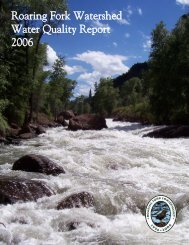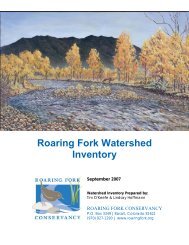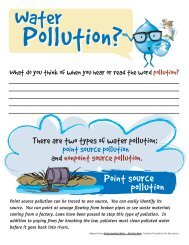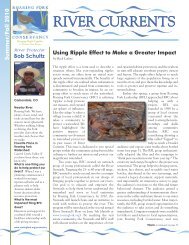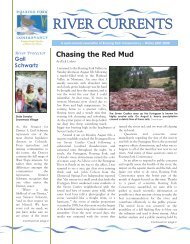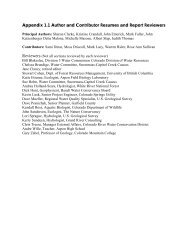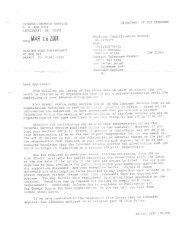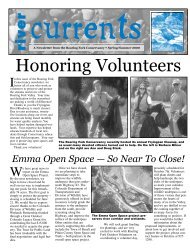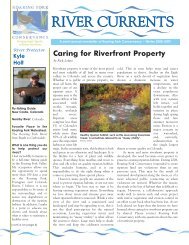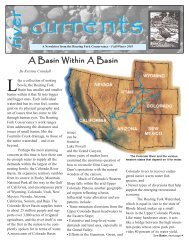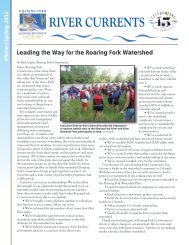The Past, Present, and Future of Transmountain Diversion Projects
The Past, Present, and Future of Transmountain Diversion Projects
The Past, Present, and Future of Transmountain Diversion Projects
You also want an ePaper? Increase the reach of your titles
YUMPU automatically turns print PDFs into web optimized ePapers that Google loves.
Figure 4. In March <strong>of</strong> 2009, workers began pouring thefoundation for the 10 million gallon Robertsdale Tank, a keycomponent <strong>of</strong> the Prairie Waters Project. (Aurora Water)develop significant new water supplies, for Denver Water tocontinue to plan for potentially unlimited population growth. 44In 1993 Denver Water announced that it would no longerenlarge its service area, instead drawing a defined service areaboundary. 45! Denver Water’s decision to limit its service area hadwidespread implications for other water providers on theFront Range. Most importantly, the decision meant thatbooming suburban areas excluded from Denver Water’sservice area would be forced to find water supplies forthemselves, without the option <strong>of</strong> relying on Denver Water’ssenior conditional West Slope water rights. 46 Withoutidentifiable sources <strong>of</strong> water to meet projected future dem<strong>and</strong>s, Front Range communities have had to scramble todevelop additional water projects, a challenging <strong>and</strong> expensive task in Colorado today. <strong>The</strong> City <strong>of</strong> Aurora, forexample, is close to completing the $754 million Prairie Waters Project, which will recycle used water from the SouthPlatte River in order to boost the city’s water supplies by some twenty percent (see Figure 4). 47 Similarly, the ParkerWater <strong>and</strong> Sanitation District has begun construction on the Rueter-Hess Reservoir, with an expected capacity <strong>of</strong>roughly 77,000 acre-feet <strong>of</strong> water, some <strong>of</strong> which is expected to be recycled (though the district has yet to identify thesource for a large portion <strong>of</strong> the reservoir’s capacity). 48 <strong>The</strong>se projects represent not only groundbreaking waterconservation <strong>and</strong> reuse projects, but also the available options for municipalities seeking additional water inColorado’s ever-tightening water supply. 49<strong>The</strong> Two Forks veto also forced Denver Water to revise its overall strategy for developing additionaltransmountain water supplies. Not only did Denver Water recognize the need to pursue water projects in anenvironmentally responsible manner, but more importantly, it decided not to undertake any future transmountaindiversion projects without first securing the cooperation <strong>of</strong> effected West Slope entities. 50 <strong>The</strong> need for such acooperative approach to future water supply projects has since been recognized by other Front Range waterproviders. 51 Today water interests on the Front Range recognize that new transmountain diversion projects will onlybe built if they are mutually beneficial to both sides <strong>of</strong> the Continental Divide. 52<strong>The</strong> Windy Gap Firming Project, M<strong>of</strong>fat System Expansion <strong>and</strong> Other Current Project Proposals<strong>The</strong> negotiations surrounding the two most recent transmountain diversion proposals – the MunicipalSubdistrict’s Windy Gap Firming Project <strong>and</strong> Denver Water’s M<strong>of</strong>fat System Expansion – demonstrate the level <strong>of</strong>cooperation required for such projects to survive beyond the conceptual stage. First, both projects follow theimplementation <strong>of</strong> progressive water conservation measures on the East Slope, a step that West Slope interests havedem<strong>and</strong>ed occur before additional diversions are even considered. 53 Likewise, both projects employ existing facilities<strong>and</strong> infrastructure <strong>and</strong> previously decreed conditional water rights, which West Slope interests have alsodem<strong>and</strong>ed. 54Yet the most important part <strong>of</strong> the Windy Gap Firming Project <strong>and</strong> M<strong>of</strong>fat System Expansion are thepotential West Slope benefits currently being proposed as part <strong>of</strong> the projects. <strong>The</strong> Municipal Subdistrict <strong>and</strong> DenverWater have teamed up to <strong>of</strong>fer a package <strong>of</strong> West Slope mitigation measures that would compensate for the impactsassociated with both projects. 55 <strong>The</strong>se measures include voluntary bypasses for transmountain diversion structures,as well as financial support for improved wastewater treatment <strong>and</strong> stream habitat restoration in the upper ColoradoRiver Basin. 56 Currently, West Slope interests are reviewing the proposal <strong>and</strong> negotiations are far from complete. 57Roaring Fork Watershed Plan!Phase II Guidance Document – Appendix Iv



